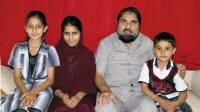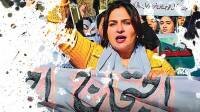These days the power of the social media is a subject of much debate and scrutiny, and last month’s general elections once again brought it into sharp focus.
There is little doubt it has emerged as one of the potential communication tools in Pakistan. Almost all major political parties as well as politicians made use of the new media for their campaigns.
The parties also used the social media effectively for dissemination of their manifestos and policies with the urban class being the target.
Rauf Klasra, a renowned columnist and Editor Investigations at Dunya Group with almost 17,000 followers on Twitter, says the social media has positively impacted the elections and electorates alike, irrespective of the challenges and threat of terrorism during the election campaign.
“The social media helped inspire a class to partake in the election process that would perhaps, otherwise have remain disenchanted and preferred staying home on the Election Day. It is a huge success of this new media.”
Besides elections, Rauf says, the social media has helped citizens unearth a number of scams and social menaces prevalent in the society. “It has empowered citizens and one of the classical examples of it was the arrest of Shahbaz Sharif’s son-in-law for his alleged involvement in the torture of an employee at a confectionary in Lahore.”
Rauf says the social media has forced politicians and the influential to behave responsibly in public lest they are exposed to the whole world through photos, videos, text and audio messages on the social media. “The educated youth remains a driving force behind a positive change in any society and fortunately our youth has started contributing in this regard.”
Imran Khan’s Pakistan Tehreek-e-Insaf and Nawaz Sharif’s Pakistan Muslim League are two major political parties that not only conspicuous by their presence on the social media but also banked heavily on the medium to lure the youth during their respective election campaigns.
The data available with the Election Commission of Pakistan shows that more than 34 percent of voters are aged less than 31 years. It shows that out of the total 85.42 million registered voters, 16.88 million or 19.77 percent of total voters are less than 26 years of age while 12.73 million or 14.91 percent are in the 26-30 age bracket. The largest segment of voters, 20.13 million voters comprising 23.58 percent of the total base, is between 31-40 years of age.
It is yet to be determined how many percent of youth voters actually turned up on the Election Day to cast their votes but in an encouraging sign, a considerable majority who used to stay indoors on polling day used their right to vote this time.
Faisal Javed Khan, a telecom executive, head of PTI Electronic Media Operations with over 31,000 followers, says the party’s social media team worked hard in disseminating Imran Khan’s messages across the world. The team comprises around 50 young and energetic people based all around the world and all of them work on volunteer basis, claims Faisal.
“Instant coverage of party gatherings was ensured through the social media as videos, pictures and messages of the party chairman were uploaded in real time for millions of followers across the globe.”
Tehreek-e-Insaf may be the biggest party on social media as its official platforms have more than three million users. Imran Khan’s official Twitter account @ImranKhanPTI and @PTIofficial had 625,174 and 138,935 followers, respectively at the time of writing this.
The PTI is also the only party that has started online broadcasting with Insaf Radio and Insaf TV. In September last year, the party’s social media team also arranged, for the first time in Pakistan’s history, a Google Hangout with Imran Khan where people from diverse segments of the society directly interacted with the party chairman and asked questions.
“Dozens of online surveys conducted before elections has helped party leaders in distribution of tickets to potential candidates and devising political campaigns. Our online surveys have also shown Imran Khan as the most popular leader of Pakistan.”
Faisal Javed foresees a broader scope of the social media in politics as he says, “Youth is adopting it as a communication tool and vibrant platform to express them.”
According to internet traffic monitoring data, there are about 8 million Facebook users in the country, of which a whopping majority are under age of 36. Also Twitter, the micro-blogging site was the 14th most visited website in Pakistan last year.
Likewise, a report published by the World Bank in July last year says Pakistan has the highest growth rate of internet of more than 16 percent in South Asia. The statistics show that internet users’ growth rate in India stands at 7.5 percent; 12.1 percent in Sri Lanka and 13.6 percent in Bhutan with respect to their populations.
Large number of people have also been using Twitter and Facebook through mobile internet as in 2010 alone the mobile internet usage registered a sharp increase of 161 percent.
Sensing substantial strength and scope of the social media, the PML-N created its first official website of the party in 2009 as a dynamic platform for users, party workers and leaders. At the end of the same year, the party also created its official Facebook and Twitter accounts to provide an integrated and interactive environment to tens of thousands of users and followers.
Asim Khan Nyazee, a PML-N media coordinator active on the social media, says the social media has helped bridge the gap between party leaders and workers besides disseminating party policies on different issues, achievements and day-to-day activities.
“The PML-N is using the social media for productive purposes unlike other parties that are using it as a propaganda tool to discredit the opponents,” he says, adding the social media helped a lot in improving image of the party and reaching out to the overseas Pakistanis and policy and opinion-makers.
However, Asim says the new media has helped the party little in broadening its vote bank as, “the creation of voters has a totally different dynamics and my party has done well on this front. We got six more seats in the elections as compared to our online surveys to assess the party’s position before elections.”
Shahbaz Sharif and Nawaz Sharif’s daughter Maryam Nawaz are also active on the social media and keep interacting with their followers besides sharing day-to-day activities of the party. Shahbaz Sharif’s twitter handle is @CMShehbaz and Maryam Nawaz’s is @MaryamNSharif and they had have 117,394 and 92,135 followers, respectively at the time of writing this. Maryam Nawaz replies to almost all her followers and experts say this has helped the party attract the youth vote.
Raza Rumi, a social media activist and director at Jinnah Institute, opines the social media has had a huge and positive impact on the elections. “It has boosted support of different parties and party leaders among masses that ultimately resulted in a vibrant election campaign.”
He says the success of Imran Khan’s party in elections also serves an indicator that the social media is getting roots at least among the educated class of the country. “If the incoming government succeeds in auctioning 3G and 4G licenses, it will help increase users of internet manifold.”
The writer is a journalist based in Islamabad.




















